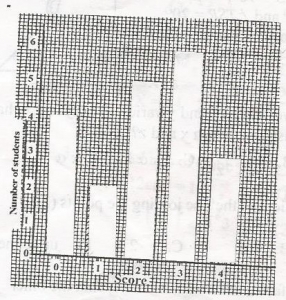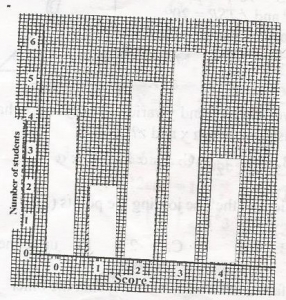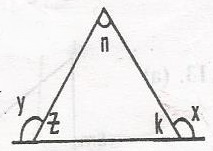Year :
2014
Title :
Mathematics (Core)
Exam :
WASSCE/WAEC MAY/JUNE
Paper 1 | Objectives
31 - 40 of 49 Questions
| # | Question | Ans |
|---|---|---|
| 31. |
If a number is selected at random from each of the sets p = {1, 2, 3} and Q = {2, 3, 5}, find the probability that the sum of the numbers is prime A. \(\frac{5}{9}\) B. 1\(\frac{4}{9}\) C. \(\frac{1}{3}\) D. \(\frac{2}{9}\) Detailed Solutionp = { 1, 2, 3}Q = {2, 3, 5} prob(prime number) = prob(1 and 2) or = prob(2 and 3) or = prob(3 and 2) There are three possibilities of the sum being prime Total possibility = 9 probability(sum being prime) = \(\frac{3}{9}\) = \(\frac{1}{3}\) |
|
| 32. |
If log 5.957 = 0.7750, find log \(3 \sqrt{0.0005957}\) A. 4.1986 B. 2.9250 C. 1.5917 D. 1.2853 Detailed Solution\(3 \sqrt{0.0005957}\)\(\begin{array}{c|c} \log No(0.0005957) & \frac{1}{3} \log \frac{1}{3} \\ \hline (0.0005957)^{\frac{1}{3}} & 4.7750 \times \frac{1}{3} \\ & 6 + 2.7750 \\\hline & 3 \\\hline & 2.9250\end{array}\) |
|
| 33. |
The probability of an event P happening is \(\frac{1}{5}\) and that of event Q is \(\frac{1}{4}\). If the events are independent, what is the probability that neither of them happens? A. \(\frac{4}{5}\) B. \(\frac{3}{4}\) C. \(\frac{3}{5}\) D. \(\frac{1}{20}\) Detailed Solutionprob(p) = \(\frac{1}{5}\)prob(Q) = \(\frac{1}{4}\) Prob(neither p) = 1 - \(\frac{1}{5}\) \(\frac{5 - 1}{5} = \frac{4}{5}\) prob(neither Q) = 1 - \(\frac{1}{4}\) \(\frac{4 - 1}{4} = \frac{3}{4}\) prob(neither of them) = \(\frac{4}{5} \times \frac{3}{4} = \frac{12}{20}\) = \(\frac{3}{5}\) |
|
| 34. |
Each exterior angle of a polygon is 30o. Calculate the sum of the interior angles A. 540o B. 720o C. 1080o D. 1800o Detailed Solutionnumber of sides = \(\frac{360^o}{\theta} = \frac{360^o}{306o}\)n = 12o Sum of interior angle = (n - 2) 180o (12 - 2) 180v = 10 x 180o = 1800o |
|
| 35. |
Find the number of term in the Arithmetic Progression(A.P) 2, -9, -20,...-141. A. 11 B. 12 C. 13 D. 14 Detailed SolutionT1, T2, T32, -9, -20 .... -141 l = a + (n - 1)d first term, a = 2 common difference d = T3 - T2 = T2 - T1 = -20 - (-9) = -9 -2 = -20 + 9 = -9 -2 = -20 + 9 = -11 -11 = -11 d = -1 last term l = -141 -141 = 2 + (\(\cap\) - 1) (-11) -141 = 2 + (-11 \(\cap\) + 11) |
|
| 36. |
In what modulus is it true that 9 + 8 = 5? A. mod 10 B. mod 11 C. mod 12 D. mod 13 Detailed Solution9 + 8 = 1717 + mod 12 = 1 rem 5 it is mod 12 |
|
| 37. |
The radii of the base of two cylindrical tins, P and Q are r and 2r respectively. If the water level in p is 10cm high, would be the height of the same quantity of water in Q? A. 2.5cm B. 5.0cm C. 7.5cm D. 20.0cm Detailed Solutionvolume of cylinder = \(\pi r^2h\)volume of cylinder p = \(\pi r^2 \times 10\) = 10\(\pi r^2\) volume of cylinder Q = \(\pi (2r)^2 h\) = 4\(\pi r^2\)h 4\(\pi r^2 = 10 \pi r^2 h\) h = \(\frac{10}{4} = 4.5cm\) |
|
| 38. |
 The bar chart shows the scores of some students in a test. How many students took the test? A. 18 B. 19 C. 20 D. 22 Detailed Solutionscore 0 = 4 studentsscore 1 = 2 students score 2 = 5 students score 3 = 6 students score 4 = 3 students = 20 students |
|
| 39. |
 The bar chart shows the scores of some students in a test. If one students is selected at random, find the probability that he/she scored at most 2 marks A. \(\frac{11}{18}\) B. \(\frac{11}{20}\) C. \(\frac{7}{22}\) D. \(\frac{5}{19}\) Detailed Solutionat most 2 marks = 5 + 2 + 4 students = 11 studentsprobability(at most 2 marks) = \(\frac{11}{20}\) |
|
| 40. |
 In the diagram, the value of x + y = 220o. Find the value of n A. 20o B. 40o C. 60o D. 80o Detailed Solutiony + z = 180oz = 180o - y x + k = 180o k = 180o - x the sum of angles in the \(\bigtriangleup\) are: n + z + k = 180 but n + 180o - y + 180o - x = 180o n + 180o - y - x = 0 but we want to find n n + 180o = x + y but x + y = 220o n + 180o = 220o &l |
| 31. |
If a number is selected at random from each of the sets p = {1, 2, 3} and Q = {2, 3, 5}, find the probability that the sum of the numbers is prime A. \(\frac{5}{9}\) B. 1\(\frac{4}{9}\) C. \(\frac{1}{3}\) D. \(\frac{2}{9}\) Detailed Solutionp = { 1, 2, 3}Q = {2, 3, 5} prob(prime number) = prob(1 and 2) or = prob(2 and 3) or = prob(3 and 2) There are three possibilities of the sum being prime Total possibility = 9 probability(sum being prime) = \(\frac{3}{9}\) = \(\frac{1}{3}\) |
|
| 32. |
If log 5.957 = 0.7750, find log \(3 \sqrt{0.0005957}\) A. 4.1986 B. 2.9250 C. 1.5917 D. 1.2853 Detailed Solution\(3 \sqrt{0.0005957}\)\(\begin{array}{c|c} \log No(0.0005957) & \frac{1}{3} \log \frac{1}{3} \\ \hline (0.0005957)^{\frac{1}{3}} & 4.7750 \times \frac{1}{3} \\ & 6 + 2.7750 \\\hline & 3 \\\hline & 2.9250\end{array}\) |
|
| 33. |
The probability of an event P happening is \(\frac{1}{5}\) and that of event Q is \(\frac{1}{4}\). If the events are independent, what is the probability that neither of them happens? A. \(\frac{4}{5}\) B. \(\frac{3}{4}\) C. \(\frac{3}{5}\) D. \(\frac{1}{20}\) Detailed Solutionprob(p) = \(\frac{1}{5}\)prob(Q) = \(\frac{1}{4}\) Prob(neither p) = 1 - \(\frac{1}{5}\) \(\frac{5 - 1}{5} = \frac{4}{5}\) prob(neither Q) = 1 - \(\frac{1}{4}\) \(\frac{4 - 1}{4} = \frac{3}{4}\) prob(neither of them) = \(\frac{4}{5} \times \frac{3}{4} = \frac{12}{20}\) = \(\frac{3}{5}\) |
|
| 34. |
Each exterior angle of a polygon is 30o. Calculate the sum of the interior angles A. 540o B. 720o C. 1080o D. 1800o Detailed Solutionnumber of sides = \(\frac{360^o}{\theta} = \frac{360^o}{306o}\)n = 12o Sum of interior angle = (n - 2) 180o (12 - 2) 180v = 10 x 180o = 1800o |
|
| 35. |
Find the number of term in the Arithmetic Progression(A.P) 2, -9, -20,...-141. A. 11 B. 12 C. 13 D. 14 Detailed SolutionT1, T2, T32, -9, -20 .... -141 l = a + (n - 1)d first term, a = 2 common difference d = T3 - T2 = T2 - T1 = -20 - (-9) = -9 -2 = -20 + 9 = -9 -2 = -20 + 9 = -11 -11 = -11 d = -1 last term l = -141 -141 = 2 + (\(\cap\) - 1) (-11) -141 = 2 + (-11 \(\cap\) + 11) |
| 36. |
In what modulus is it true that 9 + 8 = 5? A. mod 10 B. mod 11 C. mod 12 D. mod 13 Detailed Solution9 + 8 = 1717 + mod 12 = 1 rem 5 it is mod 12 |
|
| 37. |
The radii of the base of two cylindrical tins, P and Q are r and 2r respectively. If the water level in p is 10cm high, would be the height of the same quantity of water in Q? A. 2.5cm B. 5.0cm C. 7.5cm D. 20.0cm Detailed Solutionvolume of cylinder = \(\pi r^2h\)volume of cylinder p = \(\pi r^2 \times 10\) = 10\(\pi r^2\) volume of cylinder Q = \(\pi (2r)^2 h\) = 4\(\pi r^2\)h 4\(\pi r^2 = 10 \pi r^2 h\) h = \(\frac{10}{4} = 4.5cm\) |
|
| 38. |
 The bar chart shows the scores of some students in a test. How many students took the test? A. 18 B. 19 C. 20 D. 22 Detailed Solutionscore 0 = 4 studentsscore 1 = 2 students score 2 = 5 students score 3 = 6 students score 4 = 3 students = 20 students |
|
| 39. |
 The bar chart shows the scores of some students in a test. If one students is selected at random, find the probability that he/she scored at most 2 marks A. \(\frac{11}{18}\) B. \(\frac{11}{20}\) C. \(\frac{7}{22}\) D. \(\frac{5}{19}\) Detailed Solutionat most 2 marks = 5 + 2 + 4 students = 11 studentsprobability(at most 2 marks) = \(\frac{11}{20}\) |
|
| 40. |
 In the diagram, the value of x + y = 220o. Find the value of n A. 20o B. 40o C. 60o D. 80o Detailed Solutiony + z = 180oz = 180o - y x + k = 180o k = 180o - x the sum of angles in the \(\bigtriangleup\) are: n + z + k = 180 but n + 180o - y + 180o - x = 180o n + 180o - y - x = 0 but we want to find n n + 180o = x + y but x + y = 220o n + 180o = 220o &l |